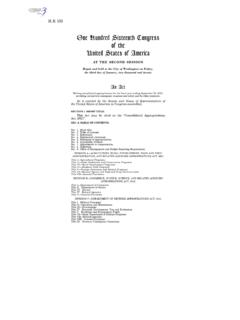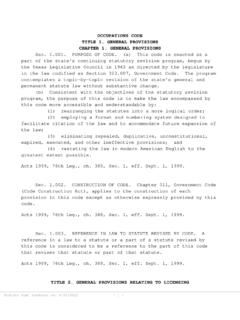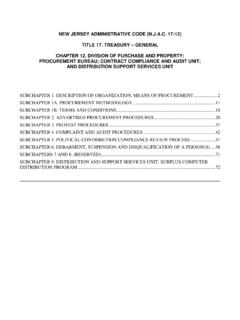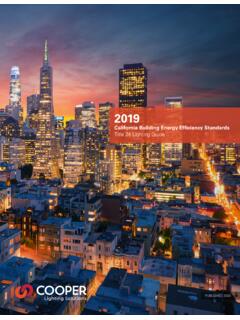Transcription of Defense Primer: Future Years Defense Program (FYDP)
1 Updated December 23, 2022 Defense Primer: Future Years Defense Program (FYDP)Background The Future Years Defense Program (FYDP, commonly pronounced fye-dip ) is a projection of the forces, resources, and programs to support Department of Defense (DOD) operations. The FYDP is compiled every year and typically completed during the programming phase of the Planning, Programming, Budgeting, and Execution (PPBE) process. DOD updates the projection during the budgeting phase to reflect DOD s final funding decisions presented in the annual President s budget request. The FYDP reflects the planned allocation of DOD resources to major strategic efforts over a multiyear period. According to the department s Future Years Defense Program (FYDP) Structure Handbook, the FYDP is intended in part to link DOD s internal review structure for programs with Congress s review structure for resources, including funding.
2 The FYDP projects DOD funding, manpower, and force structure needs over a five-year period. The projection is typically depicted with Defense resources for the two previous fiscal Years and force structure estimates for the three subsequent fiscal Years . For example, the FY2021 FYDP reflects FY2019 and FY2020 appropriations, the current budget year estimate (FY2021) as part of the five-year Program (FY2021-FY2025), and the estimated force structure through FY2028. See Figure 1. Figure 1. FY2023 FYDP Period Source: CRS graphic based on DOD Directive Primarily used as a planning tool, the FYDP allows DOD and the military services to plan for anticipated changes to programs or priorities. Such changes may include reallocating funding for a major Defense acquisition Program transitioning from research and development to procurement; shifting funding from multiple programs to a larger, higher-priority procurement; or identifying funding for an emerging priority expected to require resourcing over a period of multiple Years .
3 DOD Financial Management Regulation describes the FYDP as a series of reports that record and display resource decisions during the PPBE cycle. FYDP data are stored in a relational database. Users can enter, update, and view their organization s portion of the FYDP through a web-based application hosted on the department s classified network. title 10, Section 221, of the United States code (hereafter ), stipulates that the Secretary of Defense shall submit a FYDP to Congress in conjunction with the President s budget request. A classified version of the FYDP is generally submitted to the congressional committees with jurisdiction over Defense matters. Section 1042 of the National Defense Authorization Act for Fiscal Year 2018 ( 115-91) amended 10 221 in part to require the Secretary to submit an unclassified electronic version of the FYDP.
4 However, while the structure of the FYDP is unclassified, the actual FYDP data remains classified. DOD has proposed removing the statutory requirement to submit an unclassified FYDP to avoid inadvertently revealing sensitive information about weapons development, force structure, and strategic plans. FYDP Organization and Content The FYDP can be viewed as a way to link DOD resources (or inputs) to programs (or outputs). As such, the FYDP can serve to compare or crosswalk the department s output-focused internal review structure with the input-focused congressional review structure. The FYDP tracks the three broad categories of resources available to the DOD as its inputs: Total Obligatory Authority (TOA): Appropriated funding, in thousands of dollars; Manpower: Military end-strength and civilian full-time equivalent work Years ; and Forces: Identified as either items of equipment or combat units.
5 DOD currently groups FYDP outputs under 12 Major Force Programs (MFPs). An MFP is an aggregation of the resources (TOA, Manpower, and Forces) necessary to achieve DOD s objective or plans. Currently, six of the MFPs are considered combat force programs and six are considered support programs. MFP 01: Strategic Forces* MFP 02: General Purpose Forces* MFP 03: Command, Control, Communications, Intelligence, and Space* MFP 04: Mobility Forces* MFP 05: Guard and Reserve Forces* MFP 06: Research and Development MFP 07: Central Supply and Maintenance Defense Primer: Future Years Defense Program (FYDP) MFP 08: Training, Medical, & Other Personnel Activities MFP 09: Administration and Associated Activities MFP 10: Support of Other Nations MFP 11: Special Operations Forces* MFP 12: National Security Space *Combat force programs FYDP Structure The FYDP s structure allows a user to examine DOD plans and programs in three dimensions: 1) component (military service or Defense agency); 2) MFP.
6 And 3) appropriation title ( , military personnel, procurement, and military construction). See Figure 2. Figure Structure Source: CRS graphic based on Defense Acquisition University illustration. Program Elements Each DOD component submitting data to the FYDP assigns resources to an MFP using a unique Program element code , or PE. The 12 MFPs include thousands of PEs. Each PE is a unique alphanumeric code that identifies functional or organizational entities and their related resources. PEs may have a narrow focus (such as Navy F/A-18 squadrons) or broad focus (such as Air Force long-range strategic planning). PEs enable a user to identify allocations such as the total resources assigned to a Program , the weapon systems and support systems within a Program , specified resources in logical groupings, or selected functional groupings of resources.
7 See Figure 3 for an example of a PE. Figure Element for Night Vision Technology: PE0602709A Source: CRS graphic. The first two characters identify the MFP that contains the PE (in this case, MFP 06: Research and Development). The third and fourth characters have special uses within certain MFPs. Within MFP 06, these characters indicate a specific DOD research and development funding category (in this case, applied research). The fifth through seventh characters provide the unique identification for that specific element. The alphabetical suffix identifies the component responsible for that PE. Commonly referenced PE suffixes are A: Army BB: Special Operations Command C: Missile Defense Agency DZ: Office of the Secretary of Defense F: Air Force J: Joint Staff M: Marine Corps N: Navy Resource Identification Codes Each FYDP resource is identified by fiscal year as TOA, Manpower, or Forces using a Resource Identification code (RIC).
8 The RIC is a four-digit code that specifies the type of resource assigned to each PE. For example, TOA RICs range from 0300 to 0999 and are used to identify appropriation accounts in the President s budget request. TOA RICs generally correlate to standard account codes assigned by the Department of the Treasury. Unlike PEs, RICs are not visible in DOD s budget submission to Congress. Instead, the budget documents generally identify the resource in plain text. Relevant Statutes title 10, Ch. 9, of the code : Defense budget Matters CRS Product CRS In Focus IF10429, Defense Primer: Planning, Programming, Budgeting, and Execution (PPBE) Process, by Brendan W. McGarry Defense Primer: Future Years Defense Program (FYDP) | IF10831 VERSION 11 UPDATED Other Resources DOD Directive , The Planning, Programming, Budgeting, and Execution (PPBE) Process, updated 2017 DOD Financial Management Regulation ( ) DOD, Future Years Defense Program (FYDP) Structure Handbook, updated 2020 DOD, Defense Acquisition University, Acquisition Encyclopedia (ACQuipedia), Future Years Defense Program (FYDP) Brendan W.
9 McGarry, Analyst in Defense budget Heidi M. Peters, Analyst in Defense Acquisition Policy IF10831 Disclaimer This document was prepared by the Congressional Research Service (CRS). CRS serves as nonpartisan shared staff to congressional committees and Members of Congress. It operates solely at the behest of and under the direction of Congress. Information in a CRS Report should not be relied upon for purposes other than public understanding of information that has been provided by CRS to Members of Congress in connection with CRS s institutional role. CRS Reports, as a work of the United States Government, are not subject to copyright protection in the United States. Any CRS Report may be reproduced and distributed in its entirety without permission from CRS.
10 However, as a CRS Report may include copyrighted images or material from a third party, you may need to obtain the permission of the copyright holder if you wish to copy or otherwise use copyrighted material.

















